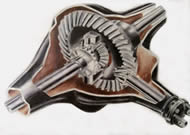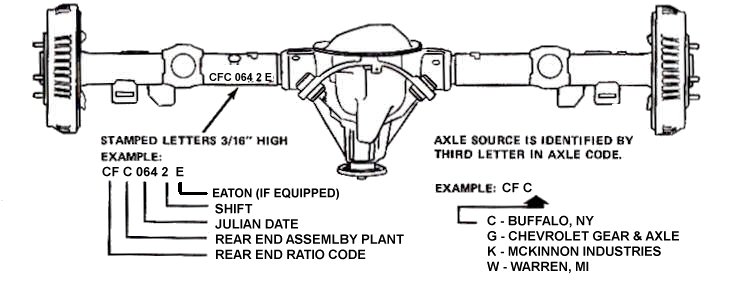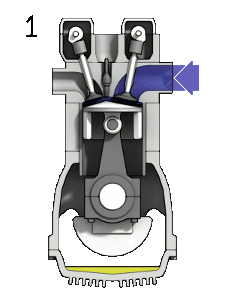Gear Ratio
|
ChevyWorld.net
|
|
A gear ratio is written in the form of something like 3.31:1 (note the location of the colon character). The number to the left of the colon represents the number of revolutions one thing must turn before the number of revolutions on the right of the colon. In the case of a ratio of 3.31:1, the driveshaft turns 3.31 revolutions to one revolution of the tire/wheel assembly. For those that didn't pay attention in math class, a ratio is expressed at the relationship between two quantities or items. Many people take the time to insert a colon ( : ) where a period ( . ) should be such as 3:31 or 4:10. Strange since a period is easier to type than a colon.
Safety first! Place a chock (a block of wood will do in a pinch) in front of the front tires so the car does not move forward and slide off the jack stands. Raise (preferably with a hydraulic jack) the rear tires off the ground, place a jack stand under the frame and lower the jack onto the jack stands confirming the tires are still off the ground.
How to determine if you have a limited slip rear end.
A limited slip rear end goes by many names depending on the manufacturer/supplier. General Motors uses the trademark name "Positraction." The name Positraction (or Posi) has morphed into a generic description of any limited slip differential.
With both rear tires off the ground rotate one of the two rear tires. If the opposite tire turns the same direction or doesn't turn at all, then the rear end is a limited slip rear end. If the opposite tires turns the opposite direction, then it's probably an open (non-limited slip) rear axle.
For a non-Positraction rear end only one rear tire needs to be off the ground:
Turn the rear tire a quarter turn counterclockwise (to the left) to remove any slack in the drivetrain.
With a piece of chalk or masking tape, mark an area lengthwise along the driveshaft that can easily be seen from the side of the car and make a corresponding mark on the rear tire as close to the centerline (vertically) as possible for reference (6 o'clock or 12 o'clock position). Rotate the rear tire clockwise or counterclockwise TWO revolutions and count the number of times the mark on the driveshaft rotates for two full revolutions of the rear tire.
The number of rotations of the driveshaft will help determine your final rear end gear ratio. For example, if the driveshaft rotates about 3 full turns, your final rear end gear ratio is probably 3.07:1 (12-bolt) or 3.08:1 (10-bolt); 3 1/3 driveshaft rotations for one full rotation of the rear tire, your final rear end ratio would be about 3.31:1; 3 3/4 driveshaft rotations would be about 3.73:1; 2 3/4 driveshaft rotations would be about 2.73:1, and so on.
Naturally you can rotate the rear tire any even number of times while counting the driveshaft revolutions - just be sure to divide the numbers accordingly. If you turn the rear tire SIX times instead of TWO, you must divide the driveshaft rotations by THREE since SIX is three times greater than TWO.
For a Positraction rear end both rear tires need to be off the ground:
The same procedure is applicable for a limited slip (GM's trademark name is "Positraction") only ONE revolution of the rear tire is needed. Naturally you can rotate the rear tires as many times as you like - just be sure to divide the driveshaft rotations by the same number.
You can calculate a desirable rear gear ratio based on your transmission type and overall tire diameter to help you determine your speed at any given RPMs knowing the (1) transmission, (2) tire size, and (3) final rear end ratio. Knowing any two of the three can help you find the third. If you know your tire size and approximate RPM at a given speed, you can play with the rear end gear ratio number to determine your overall rear end gear ratio. RPM Calculator.
To calculate MPH from a KNOWN tire diameter, KNOWN rpm, and KNOWN rear end gear ratio the formula is: MPH = (Tire Diameter x RPM) / (Gear ratio x 336)
To calculate your final gear ratio from a KNOWN tire diameter, KNOWN rpm, and KNOWN mph the formula is: Final Gear = ((Tire Diameter x RPM) / MPH) / 336.
The tire size can affect the car's overall speed at the same engine rpm. For example a car with a tire diameter of 27 inches and a 3.31:1 rear gear ratio at 3000 rpms will be speeding along at 72.831 mph. If you replace the 27 inch diameter tire with a 30 inch diameter tire the car with the same 3.31:1 rear gear ratio at 3000 rpms is now speeding along at 80.924. To get back to the 72.831 mph one would need to run the engine at 2700 rpms and at 3000 rpms the overall gear ration has changed to 3.68:1.
Consequently a smaller diameter tire, say a 24 inch diameter tire, the same car with the 3.31:1 gear an 3000 rpms is now only speeding along at 64.739 mph. To get back to 72.831 mph, one would need to increase the rpms to 3375 and at 3000 rpms the overall gear ratio has changed to 2.94:1.
Engine Compression
An engine's static compression ratio is defined in much the same manner and is expressed the same way. The compression ratio is the ratio between the volume of the cylinder and combustion chamber at their maximum and minimum values. The specific cylinder bore and/or the engine's crankshaft stroke dimensions are of no consequence, compression ratio measures maximum vs. minimum volume regardless of what those volumes are. A 350cid engine's cylinder with a maximum volume of 44 cubic centimeters (cc) can have the same 10.25:1 compression ratio as a 454cid engine with a maximum cylinder volume of 57 cc. A compression ratio of 10.25:1 means the maximum volume of the cylinder is 10.25 times greater than the minimum volume of the cylinder.
The volume of the combustion chamber of the cylinder head will also affect the engine's compression ratio since that volume is considered in the maximum/minimum volume area.
|
CDs/Coins/Gifts/Stickers
See more ChevelleCD Chevy-related products here ↓
Mac's Registries
See more about Chevrolet/Camaro/Monte Carlo/Nova/HHR/SSR/Acadian/Beaumont registries here ↓
Chevrolet Clubs |
|
|
|









